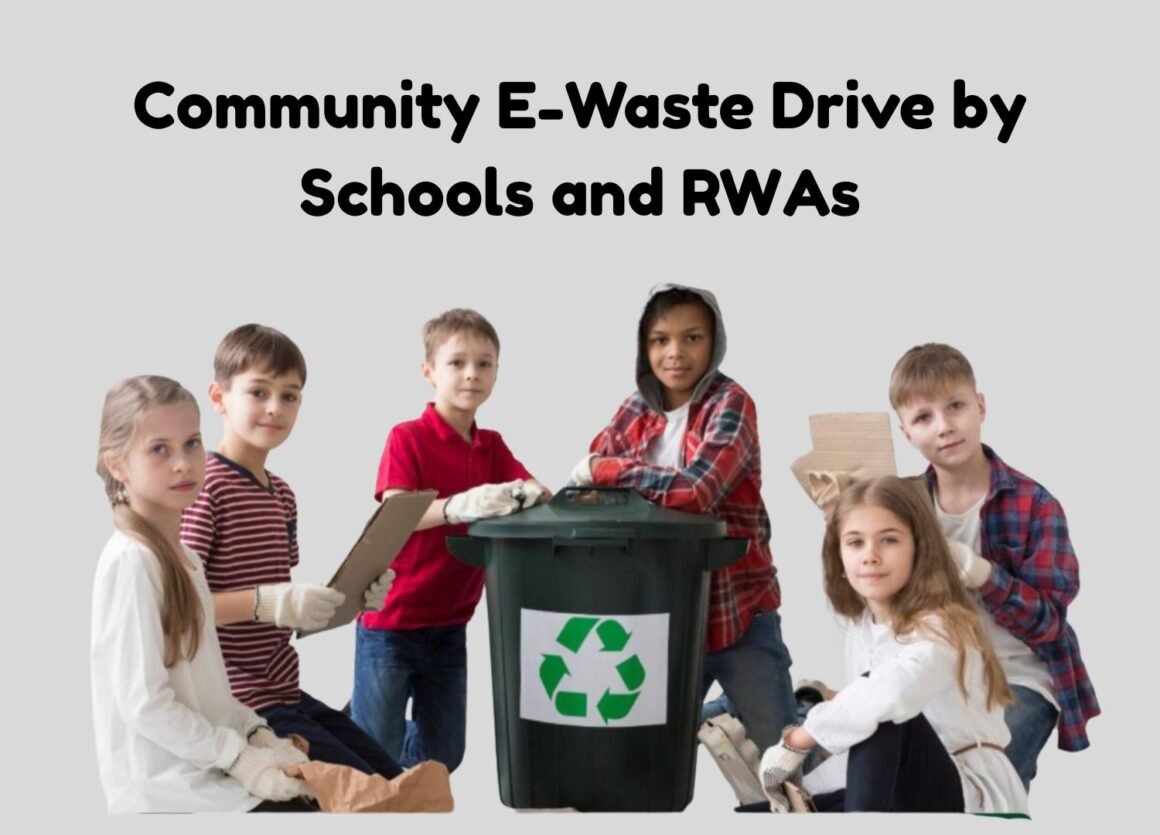Citizen-Led E-Waste Drives: Role of Schools and RWAs”
Electronic waste, or e-waste, has emerged as one of the fastest-growing waste streams in the world, driven by rapid technological upgrades and consumer demand for electronic products. Improper disposal of e-waste not only harms the environment but also poses severe health risks due to hazardous substances like lead, mercury, cadmium, and brominated flame retardants.

While governments and industries play a crucial role in e-waste management, citizen-led initiatives have proven equally important. In particular, schools and Resident Welfare Associations (RWAs) stand out as powerful community anchors that can mobilise households and students to participate in responsible e-waste collection and recycling.
Understanding the Importance of Citizen Participation
Government regulations alone cannot solve the e-waste crisis. Most e-waste is generated directly from households, small offices, and educational institutions. Unfortunately, much of this waste ends up mixed with domestic garbage or is sold to informal scrap dealers who dismantle it using unsafe methods. Citizen-led drives help bridge the gap between awareness and action by creating structured collection systems at the local level.
Why Citizen-Led E-Waste Drives: Role of Schools and RWAs”
Schools and RWAs are key social institutions that already have organised networks, communication channels, and trust within communities. Their involvement makes e-waste management practical and accessible for ordinary citizens.
Schools can:
- Educate students and families about e-waste hazards.
- Serve as accessible drop-off points for collection drives.
- Inspire young “eco ambassadors” who influence behaviour change.
RWAs can:
- Mobilize entire neighbourhoods for doorstep awareness.
- Set up regular collection points inside residential complexes.
- Partner with authorised recyclers for safe disposal.
Together, schools and RWAs can transform e-waste recycling into a mass community movement.
Role of Schools in Citizen-Led E-Waste Drives
Schools are ideal platforms for long-term awareness and responsible action. Their role includes education, engagement, and mobilization.
Environmental Education
Schools can integrate e-waste awareness into science and environmental studies. Activities like poster-making, debates, and project-based learning make students conscious of sustainability at an early age.
Collection Drives
Many schools host periodic e-waste collection drives where parents and students bring old phones, chargers, laptops, and electronic toys. These drives are often organized in collaboration with NGOs or recycling companies.
Student Eco-Clubs
Eco-clubs led by students can take ownership of e-waste initiatives, turning drives into recurring programmes instead of one-time events.
Linking with CSR Initiatives
Large companies often support such school campaigns under corporate social responsibility (CSR) programmes. Schools can gain resources like awareness kits, bins, and logistics support.
Citizen-Led E-Waste Drives: Role of Schools and RWAs”
RWAs serve as neighbourhood-level governance units, giving them a powerful role in citizen-led e-waste management.
Community Awareness
RWAs can conduct meetings, put up posters, and circulate educational messages on WhatsApp groups to spread awareness about proper e-waste disposal.
Convenient Collection Points
By placing e-waste bins at society gates or clubhouses, RWAs make collection easy for residents. They can also offer doorstep collection for senior citizens.
Partnerships with Recyclers
RWAs can tie up with authorised e-waste recyclers or Producer Responsibility Organizations (PROs) to ensure safe recycling as per E-Waste Management Rules.
Documentation and Transparency
They can ensure proper receipts and certificates of recycling are obtained, building trust among residents.
Joint Action Model: Schools + RWAs + Recyclers
Citizen-led e-waste drives work best through collaboration. A simple model includes:
- Awareness led by schools and RWAs.
- Collection at secure local points.
- Transportation handled by recycling partners.
- Certification issued by authorised recyclers for accountability.
Challenges and Solutions: Citizen-Led E-Waste Drives: Role of Schools and RWAs
| Challenge | Solution |
|---|---|
| Low awareness | Run campaigns and demonstrations |
| Space for storage | Use temporary collection bins |
| Data privacy concerns | Encourage data wiping before disposal |
| Trust issues with recyclers | Partner only with authorised companies |
Conclusion: Citizen-Led E-Waste Drives: Role of Schools and RWAs
Citizen-led e-waste drives are a practical and scalable solution to India’s e-waste crisis. Schools help shape responsible future citizens, while RWAs mobilize households to act today. When both join hands with formal recyclers and local authorities, e-waste management becomes cleaner, safer, and more community-driven. The success of such drives ultimately depends on sustained participation, awareness, and leadership at the grassroots level.
Real-Life Examples of Citizen-Led E-Waste Drives in India
Citizen-driven recycling movements are gaining momentum across India. Here are some inspiring examples:
- Delhi – School-Led E-Waste Movement: Several Delhi schools, under the “Mission Zero E-Waste” programme, partnered with the Ministry of Electronics & IT and Digital India Corporation to set up campus-based e-waste collection centres. These schools collected more than 35 tonnes of e-waste in one year.
- Bengaluru – RWA-Led Recycling Revolution: The Whitefield Rising community launched monthly e-waste drives in collaboration with Saahas Zero Waste and Karo Sambhav. Residents from over 22 residential societies now participate regularly, diverting over 5 tonnes of e-waste from landfills every quarter.
- Mumbai – School-RWA Partnership Model: In the suburbs of Andheri and Powai, NGOs and RWAs have jointly organized collection camps during weekends. Many schools provided space as temporary drop-off centres, resulting in the collection of laptops, mobile phones, cables, and other gadgets totaling over 8,000 kg.
- Chandigarh – Student Eco Clubs in Action: The Chandigarh Pollution Control Committee (CPCC) launched school awareness drives under the Swachh Bharat Mission. Students not only collected e-waste but also volunteered to educate households in their sectors, collecting more than 1.5 tonnes in three weeks.
Benefits of Citizen-Led E-Waste Drives
Citizen participation brings measurable environmental benefits and strengthens community responsibility. Key benefits include:
- Environmental Protection: Prevents hazardous materials from contaminating soil and water.
- Promotes Recycling Economy: Recovered components create raw materials for new products.
- Boosts Formal Recycling Sector: Drives feed e-waste into authorized channels instead of the informal sector.
- Encourages Behaviour Change: Builds habits of proper disposal among youth and households.
- Supports Circular Economy: Encourages repair, reuse, and responsible buying of electronics.
Policy Support and Legal Framework in India
India has a structured legal ecosystem for e-waste management:
- E-Waste (Management) Rules, 2022: These rules introduced Extended Producer Responsibility (EPR), making producers accountable.
- Role of State Pollution Control Boards (SPCBs): RWAs and schools must tie up only with authorised dismantlers and recyclers listed with SPCBs.
- Digital EPR Portal: Citizens, recyclers, and producers now use a transparent online tracking system.
These regulations support community-led initiatives by giving them access to certified recycling partners and ensuring accountability.
How to Organize an E-Waste Drive: Step-by-Step Guide
- Planning: Identify target households or schools, set dates, and contact recyclers.
- Awareness: Use posters, WhatsApp messages, and school assemblies.
- Collection: Set up safe drop-off points and segregate items.
- Transportation: Hand over to authorised recyclers.
- Certification: Collect proof of recycling and share results.
List of Acceptable E-Waste Items
- Mobile phones, tablets, chargers, batteries
- Laptops, printers, keyboards, cables
- TVs, DVD players, set-top boxes
- Refrigerators, washing machines, microwaves
- LED bulbs, power banks, Bluetooth devices
Conclusion
Citizen-led e-waste drives are a powerful way to create change from the grassroots. Schools build environmental responsibility in future generations, while RWAs create action at the residential level. If such drives are promoted consistently with government support and authorised recycling partners, communities across India can significantly reduce the environmental footprint of discarded electronics.
FOR MORE BLOGS – beyondthepunchlines.com

 Add to favorites
Add to favorites






